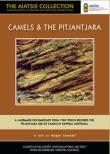AustLit
The material on this page is available to AustLit subscribers. If you are a subscriber or are from a subscribing organisation, please log in to gain full access. To explore options for subscribing to this unique teaching, research, and publishing resource for Australian culture and storytelling, please contact us or find out more.
Latest Issues
AbstractHistoryArchive Description
'From the 1920s onwards, when motor vehicles displaced camels as a mode of supply in central Australia, camels gradually went feral. As this film shows, however, in the 1960s, the Pitjantjara were making good use of camels to facilitate their travels and connections with other areas.'
'This remarkable film, shot in 1968 (released in 1969) follows a group of Pitjantjara men, led by “Captain”, a veteran cameleer, who travel out from their base at Areyonga Settlement, to capture a wild camel, tame it and add it to their domestic herds. They then use camels to help transport a large group of people from Areyonga to Papunya, three days’ walk away.' (Source: Ronin Films website)
Notes
-
Ronin Films wishes to advise Aboriginal and Torres Strait Islander people that this film may contain images and voices of deceased persons.
Publication Details of Only Known VersionEarliest 2 Known Versions of
Last amended 17 Nov 2015 11:48:34
Export this record




